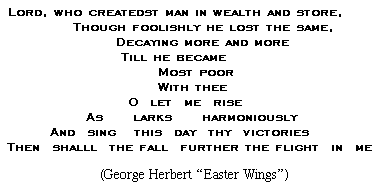|
When you write about a literary work or refer to it in a literary response journal or an essay, you will frequently need to quote from it. Below are some rules to follow when you quote from a literary work. Note: You would double-space all typed material. RULE 1: Punctuate the title of a literary work properly for its genre. Whenever you mention the title of a novel, underline it or use italics. Capitalize the first word in the title, the last word in the title, and any other major words in between. (Underlining and italics are the same.)
Whenever you mention the title of a full-length play, underline it or use italics. Put quotation marks around the title of a one-act play (unless it is an exception like Everyman)..
Whenever you mention the title of a poem, put quotation marks around the title. An exception would be a book-length poem like The Odyssey. Capitalize the first word in the title, the last word in the title, and any other major words in between.
Whenever you mention the title of a short story, put quotation marks around the title.
RULE 2: Whenever you quote an uncommon word or a longer phrase that appears in the literary work, put quotation marks around it. In many essays, especially those on literary topics, the most effective use of quotation is to incorporate short, illustrative passages from the text into the essay.
Integrate the quoted material within your own sentence. Avoid Quote Lumps! So, if the following epigraph is a passage from which you wish to quote, take only part of it and integrate selected phrases within your own sentence.
RULE 3: Whenever you quote part of a phrase but choose to leave out part of the passage, use the ellipsis ... to indicate where you have omitted words.
RULE 4: Longer quotations from the work you are discussing can be effective, though you should always avoid quoting more than is necessary. If a quotation runs to more than three lines in verse or four typed lines in prose, set if off from your text on separate, indented lines within your paragraph. When several lines are cited, they should be especially significant. Do not quote and run. You should "set up" the quote by introducing it and justify such a long quote by explaining its importance afterwards -- "saying goodbye".
Technically, the format for longer quotations is very precise. Begin a new line, indenting ten spaces from the left margin, and typing it double-spaced, without adding quotation marks. A colon generally introduces a quotation displayed in this way, though sometimes the context may require a different mark of punctuation, or none at all. If you are quoting only a single paragraph, or part of one, do not indent the first line more than the rest. Do not use quotation marks unless they enclose dialogue, as in the example above. The inset serves the same purpose as the quotation marks.
Ideally, you would introduce the quotation, use only the relevant part of the passage, and then explain the quotation's significance. In any case you should discuss the passage in some detail after it is quoted; it is not enough to quote a chunk from a work to support your argument and to leave it at that. Your reader will want to know how and why the passage supports your point. RULE 4: Special rules apply for verse and drama written in verse (Yes, that means Shakespeare). You should follow the lineation, line indentation and format of the original. Whenever you quote a phrase that begins on one line but ends on the next, indicate where the first line stops by using a slash mark.
Here's a poem whose format must be preserved exactly:  If you omit a whole line or more, you should indicate the omission by a row of spaced periods the length of a line (sort of like a super ellipsis). RULE 5: Punctuation of quotations can be very confusing, especially if you also need to indicate line numbers or page numbers as part of your parenthetical citation. The usual practice is to place periods and commas inside quotation marks, regardless of logic. Other punctuation marks - question marks, exclamation marks, semicolons, and colons - go where logic would dictate. Thus, we might see the following sentences in a paper about Robert Frost:
|